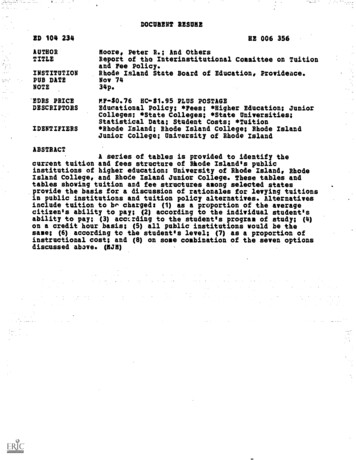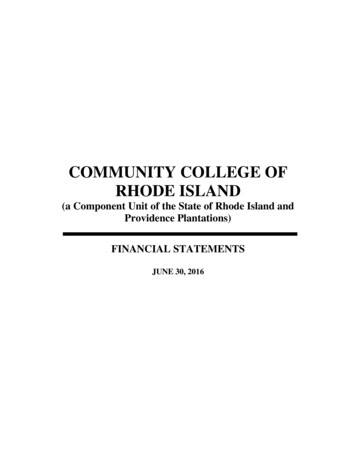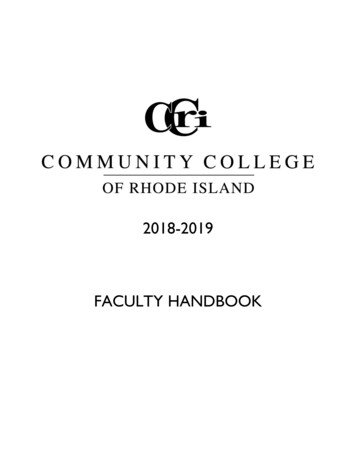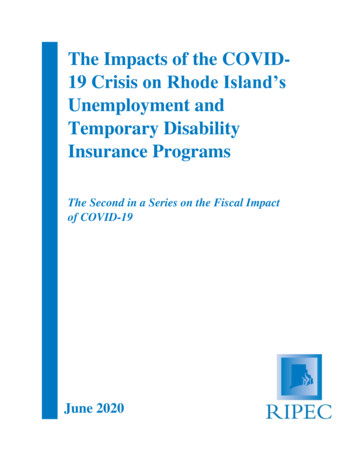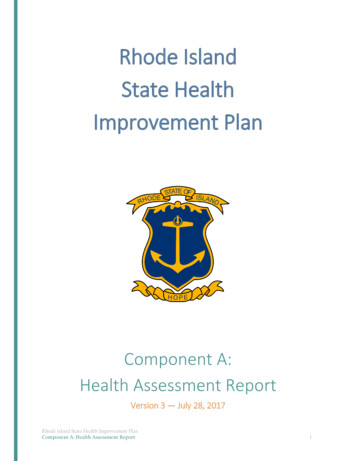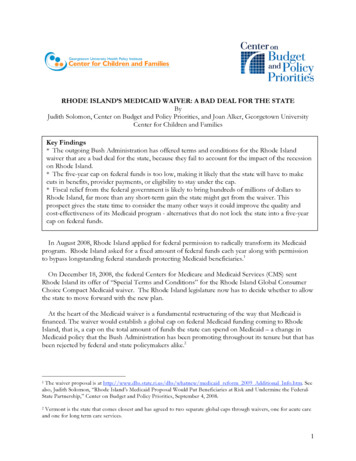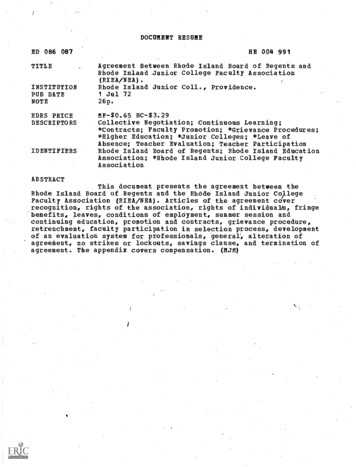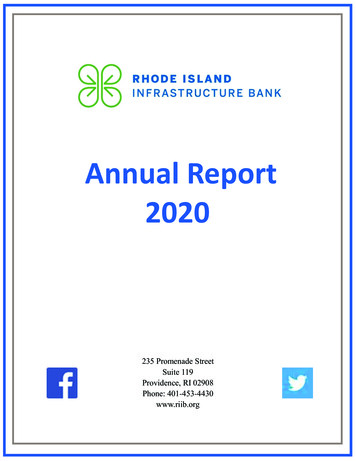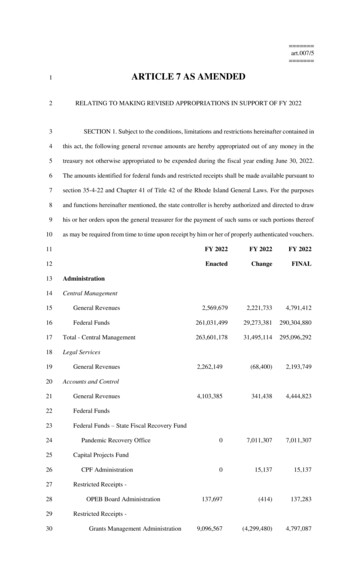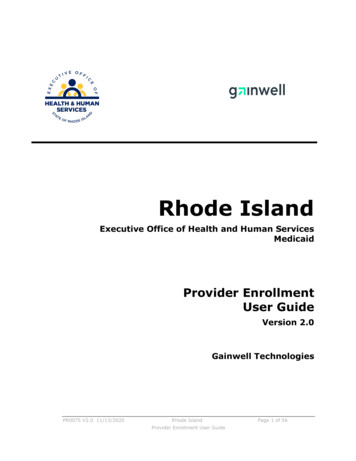
Transcription
RIPEC Policy BriefA SPECIAL PUBLICATION OF THE RHODE ISLAND PUBLIC EXPENDITURE COUNCILAnalysis of RIte Share ProposalThis RIPEC Policy Brief analyzes the governor’s proposal to expand RIte Share enrollmentby establishing reporting and information sharing requirements for for-profit employers with50 or more employeesIntroductionIn January 2020, Governor Gina Raimondo released her fiscal year (FY) 2021 budget proposal forconsideration by the General Assembly.1 Article 20, Section 13 of that proposal contains revisionsto Rhode Island’s RIte Share program, through which the state pays out-of-pocket expenses onemployer-sponsored health insurance (ESI) for Medicaid-eligible employees and their families.The RIte Share program additionally provides wrap-around coverage that is offered throughMedicaid but not through the employee’s ESI. With the goal of increasing RIte Share participation,the governor’s proposal would require Rhode Island’s for-profit employers with 50 or moreemployees to submit annual and quarterly reports, provide employees with RIte Share enrollmentinformation, and participate in employer education and outreach campaigns. The remainder of thisRIPEC Policy Brief places this proposal in historic and national context, breaks down the proposalin greater detail, and comments on elements of the plan that may require greater consideration.Premium Assistance ProgramsThrough premium assistance programs, states may elect to pay all or part of ESI premiums onbehalf of Medicaid-eligible employees and their families. In doing so, a state stands to expendfewer resources than if it paid for Medicaid or Children’s Health Insurance Program (CHIP)services in full. While premium assistance programs are designed to lower state expenditures,savings are not assured, and cost-effectiveness must be determined on an individual basis.2Statewide authority to establish premium assistance programs is derived from Title XIX of theUnited States Social Security Act.31The fiscal year runs from July 1 to June 30.Medicaid and CHIP Learning Collaboratives, “Medicaid Premium Assistance in the Employer Sponsored InsuranceMarket,” January 28, 2015.3United States Social Security Act, Title XIX – Grants to States for Medical Assistance Programs, Section 1906A –Premium Assistance.2Page 1 of 12
As shown in the map below, 38 states—including Rhode Island—operate a premium assistanceprogram.4Figure 1Source: US Department of LaborRIte ShareRhode Island Health Reform ActRhode Island’s premium assistance program, RIte Share, was established in 2000 as part of HealthReform Rhode Island. Signed into law by Governor Lincoln Almond, Health Reform Rhode Islandcomprised a package of healthcare reform bills that collectively sought to ensure “that all RhodeIslanders have access to affordable health care.” 5More specifically, RIte Share was introduced as a means of both combatting an unanticipatedgrowth in the expense of administering RIte Care—Rhode Island’s Medicaid managed careprogram—and shoring up the state’s private insurance market.6 By 2000, Rhode Island had one ofthe nation’s lowest rates of those without health insurance; 5.9 percent of residents were uninsured.This was in part due to the expansion of RIte Care, which was introduced in 1994 under a MedicaidSection 1115 demonstration waiver. In the late 1990s, access to RIte Care increased as incomerestrictions loosened. However, the level of growth in RIte Care enrollment outpaced projections,leading to fiscal concerns on the part of state government, as well as projections of accompanyingU.S. DOL, “Premium Assistance Under Medicaid and the Children’s Health Insurance Program.”R.I. EOHHS, RIte Care/RIte Share Annual Report, November 2006.6Sharon Silow-Carroll, et. al., “Assessing State Strategies for Health Coverage Expansion: Case Studies of Oregon,Rhode Island, New Jersey, and Georgia,” Commonwealth Fund, November 2002; R.I. EOHHS, “RIte Care.”45Page 2 of 12
instability in the commercial market. Adding to this sense of instability, two of the five healthplans in the state left in 1999, while two other plans stopped accepting RIte Care enrollees.7In response, Governor Almond convened a health care working group in January 2000. Theproduct of this group’s labor, Health Reform Rhode Island, created RIte Share, introduced costsharing for certain enrollees, instituted rate stabilization and other reforms to the small groupmarket, and established new financial solvency accountability standards for insurers.8RIte Share began operation in February 2001.9How Does RIte Share Work?What follows is a description of how individuals and families currently become enrolled in theRIte Share program, and how that program functions. However, given that enrollment in the RIteShare program has declined over the last several years (see Figure 7) without any evidence of acorresponding decline in Medicaid eligible individuals and families with access to ESI suggeststhat at least one part of the process described below is not operating as intended.The RIte Share process is currently initiated when anindividual or family applies for Medicaid and signalson their application that they have access to ESI. If theemployer and ESI are unknown to the Medicaid office,a RIte Share application is sent through the mail for theemployee to complete—with the aid of theiremployer—and return.10At this point, the Medicaid office determines whetherit would be cost effective for the state to enroll theemployee (and, if applicable, their family) in RIteShare. In making that assessment, the Medicaid officemust judge if the cost of the Medicaid premium isgreater than RIte Share costs, as reflected in theequation pictured in Figure 2. If the ESI offered is notcost-effective for the state, then the individual orfamily is enrolled in Medicaid, but if the ESI is costeffective, a RIte Share notice of approval is sent to boththe employee and employer. This portion of theenrollment process is bypassed for employees whoseemployers already participate in RIte Share; suchemployees will be sent an enrollment request after theyapply for Medicaid. After receiving a notice ofFigure 2RIte Share Cost-EffectivenessCalculatorIf this equation is true, RIte Share is thecost-effective optionESI employeepremium ESI costsharingMedicaidmanaged carepremium ESI noncoveredservices costs RIte ShareadministrativecostsSource: RI EOHHS“Assessing State Strategies for Health Coverage Expansion.”Ibid; RIte Care/RIte Share Annual Report, November 2006.9R.I. DHS, “Rhode Island’s RIte Share Premium Assistance Program: Estimated Savings, State Fiscal Year 2005,”January 2006.10R.I. EOHHS, “RIte Share – Rhode Island’s Premium Assistance Program,” 2020 Handout.78Page 3 of 12
approval, the employee is required to both enroll themselves and any dependents in ESI and havetheir employer sign a verification form. A welcome letter is thereafter sent to the employee withinformation on how the program works and how to use benefits.11Typically, the employer pays for any costs covered for non-RIte Share participants, while thecovered individual receives a proactive monthly payment from the state to cover the employee’sshare of the ESI premium. However, an employer may choose to receive an employee’s share ofthe premium directly from the state, rather than deducting that sum from an employee’s paycheck.Individuals enrolled in RIte Share must present both their ESI and Medicaid cards when seekingmedical care, and providers bill the employer’s plan first, and the state thereafter receives a bill forcoinsurance or deductible costs. RIte Share covered individuals have access to wraparoundservices—such as non-emergency transportation services—and those, and any other Medicaidservices not offered under ESI, are billed to the state by providers.12To keep RIte Share lists current, employers participating in RIte Share produce quarterly andannual reports for the Medicaid office. Annual notices are sent by the Medicaid office to employersto request renewal information (to redetermine cost effectiveness), and every quarter a list of RIteShare enrolled employees is sent to employers, who review and confirm information regardingindividuals’ continued employment, as well as their plan, rate, and tier information. These reportsare not submitted digitally but instead are scanned or faxed back to Medicaid’s RIte Share unit.13Adult individuals who are eligible for RIte Share but refuse to enroll face losing access to Medicaidfor themselves and other adults in the household, but neither minor dependents nor pregnantindividuals can lose access to Medicaid under these circumstances.14 The frequency at which RIteShare eligible individuals lose insurance due to a refusal to participate in the program is unclear.The additional obligations of employees, employers, and Rhode Island’s Medicaid office underRIte Share, as compared to Medicaid, are laid out in Figure 3.11Ibid.Ibid.13Ibid.14Ibid.12Page 4 of 12
Figure 3Additional Obligations* of Rhode Island Medicaid Office, Individuals, & Employers under RIte ShareMedicaidApply for MedicaidRIte ShareApply for MedicaidFill out & send RIte Share applicationIndividual/EmployeePresent Medicaid card to healthcare providersEnroll in ESIAsk employer to fill out employer verification formPresent Medicaid & ESI cards to healthcareprovidersMay pay employee portion of ESI with moneyproactively sent by the state (otherwise, funds sentto employer, who becomes responsible forpayment)**Help employees fill out RIte Share applicationSign employer verification formRespond to annual notices from the Medicaid officeabout healthcare renewal informationEmployerRespond to quarterly notices from the Medicaidoffice about RIte Share participating employeesN/APay employer portion of ESIDetermine if individual &/or family applyingqualifies for MedicaidSend Medicaid card to qualifying individuals &familiesMay pay employee portion of ESI with moneyproactively sent by the state (otherwise, funds sentto employee, who becomes responsible forpayment)**Determine if individual &/or family applyingqualifies for MedicaidDetermine cost effectiveness of enrollingindividuals & families in RIte Share under specificESI plans; send out notices of approval or elseenroll individuals in MedicaidSend Medicaid card to qualifying individuals &familiesSend out annual notices to employers abouthealthcare renewal information; process responsesfrom employersRhode IslandMedicaid OfficeSend out quarterly notices to employers about RIteShare participants; process responses fromemployersDetermine when individuals or families are nolonger Medicaid eligibleDetermine when individuals or families are nolonger RIte Share eligibleDiscontinue Medicaid services from adults who areeligible for, but refuse to participate in, RIte SharePay providers for healthcare services; provide &pay for wraparound servicesProvide & pay for employee portion of ESI byproactively sending money to employer oremployee; pay provider for services offered throughMedicaid but not ESI; provide & pay forwraparound services* This table does not detail every obligation of the Medicaid Office or Medicaid participants under the Medicaid program, but rather shows whatadditional obligations exist under RIte Share** Both models are used under the current RIte Share programSource: RI EOHHSPage 5 of 12
Eligibility, Enrollment, and Cost TrendsTo qualify for RIte Share, participants must be eligible for Medicaid. Prior to 2014, Medicaid wasaccessible only to low-income pregnant women, seniors, adults withdisabilities, children up to age 19, and parents with children under ageFigure 4FederalPoverty Level18. Low-income status is dictated by the Federal Poverty Level (FPL)(FPL), 2020and Medicaid eligibility is determined by applying differing FPLpercentages to the groups listed above.15 For instance, parents withFamily SizeFPLchildren under the age of 18 are eligible for Medicaid if their income1 12,760is at or below 133 percent of FPL, while pregnant women are eligible217,240if their income is at or below 253 percent of FPL. With few321,720426,200exceptions, Medicaid recipients must either be citizens of the United16530,680States or legal resident immigrants with five years of residency.The 2014 implementation of Medicaid expansion under the federalAffordable Care Act (ACA) opened Medicaid to a new population ofsingle adults. Namely, individuals between the ages of 19 and 64 whoare not pregnant and do not have special needs, but who do haveincome at or below 133 percent of FPL became Medicaid eligible.1767835,16039,64044,120Source: Healthcare.govAs Figure 5 highlights, there were year-over-year increases in the number of Rhode Islandersenrolled in Medicaid from FY 2009 to FY 2018. However, FY 2014 and FY 2015 (when Medicaidexpansion took affect) saw particularly large increases, with enrollment growing from under200,000 in FY 2013 to more than 270,000 in FY 2015. In total, Medicaid enrollment in the OceanState grew by over 140,000 individuals between FY 2009 and FY 2018, with approximately316,000 Rhode Islanders covered by Medicaid in FY 2018.15FPL rates are based on pretax income and are issued annually by the U.S. Department of Health and HumanServices. See: “Federal Poverty Level,” HealthCare.Gov.16R.I. EOHHS, “RIte Care.”17R.I. EOHHS, “Medicaid Expansion.”Page 6 of 12
While Medicaid enrollment has increased in Rhode Island, Figure 6—which displays both thefederal and state portion of Medicaid expenditures for covered services—highlights that so toohave Medicaid expenditures.18 Between FY 2009 and FY 2018, total Medicaid expenditures forcovered services grew from 1.7 billion to 2.6 billion, with the state share of that increase growingfrom 661.0 million to 1.0 billion.19This increase substantially affects Rhode Island’s budget; Medicaid is the largest and fastestgrowing category of state government expenditures.20 Importantly, increased enrollment is onlypart of the growing cost of administering Medicaid; rising medical costs are a major contributor.Additionally, it is worth noting that Medicaid and Medicaid expansion are funded somewhatdifferently. Both are financed through a mixture of federal and state funds. For Medicaid, thefederal share of expenses is dictated by the federal medical assistance percentage (FMAP), whichdiffers for each state and is determined by per capita income. Typically, the federal governmentcovers approximately 50 percent of Rhode Island’s Medicaid costs.21 Expenditures arising from18Covered services include the services, drugs, supplies, and equipment for which coverage benefits are availableunder health care plans. Covered services make up most Medicaid expenditures. See: “Glossary of Health Coverageand Medical Terms,” HealthCare.Gov.19R.I. EOHHS, SFY 2009 – SFY 2018 Medicaid Expenditure Report.20R.I. Auditor General, State of Rhode Island Single Audit Report, FY 2018.21Rhode Island’s Federal Medicaid Assistance Percentage (FMAP) rate was set at 52.95 percent for federal FY 2020(October 1, 2019 through September 30, 2020). However, the Families First Coronavirus Response Act (passed March18, 2020) increased the FMAP rate for each state, including Rhode Island, by 6.2 percentage points from January 1,2020 through the end of the calendar quarter when the COVID-19 public health emergency terminates. Kaiser FamilyFoundation, Federal Medical Assistance Percentage (FMAP) for Medicaid and Multiplier; Families First CoronavirusResponse Act, Section 6008.Page 7 of 12
Medicaid expansion, on the other hand, are covered at a rate of 90 percent by the federalgovernment.22Despite year-over-year increases in Rhode Island’s Medicaid population, RIte Share enrollmentdecreased substantially between FY 2009 and FY 2018, with year-over-year decreases beginningin FY 2013 and a total enrollment decrease of 6,184 individuals (52.6 percent). In this period, thepercentage of the Medicaid eligible population enrolled in RIte Share dipped from 6.7 percent to1.8 percent. RIte Share participation further decreased in FY 2019 (to 4,525 individuals) andthrough the first seven months of FY 2020, with a total of 3,279 enrollees in January 2020.23Medicaid and RIte Share eligibility, enrollment, and cost trends highlight both that the currentprogram is not effective in enrolling RIte Share eligible individuals and families, and that the Stateof Rhode Island has lost potential savings that could be achieved if RIte Share was more effectivelyadministered. The question remains, however: would the proposal unveiled in the governor’s FY2021 budget effectively address this issue?22From 2014 to 2016, the federal government covered 100 percent of Medicaid expansion costs. The federalgovernment’s rate of cost coverage thereafter declined along a set schedule, until it reached 90 percent coverage in2020. See: R.I. Senate Fiscal Office, Issue Brief, “Medicaid,” September 8, 2014.23R.I. House Fiscal Advisory Staff, Staff Presentation to the House Finance Committee, March 10, 2020.Page 8 of 12
FY 2021 Budget Proposal – RIte ShareProposalWith the intention of bolstering RIte Share’s flagging enrollment numbers and accordinglydecreasing the state’s Medicaid expenditures, Article 20, Section 13 of Governor Raimondo’s FY2021 budget proposal includes a plan to require for-profit employers with 50 or more employeesat any time in the previous fiscal year to report information about both their ESI and theirMedicaid-eligible workforce to the Rhode Island Division of Taxation and the Executive Officeof Health and Human Services (EOHHS), which includes the Medicaid office and administers theRIte Share program. Figure 8 details employer requirements under the proposal, including thefrequency of the reporting requirements and the information required.24 The first employersubmissions under this program would occur between November 15, 2020 and December 15,2020.While participating employers currently report health insurance benefit information, the text of theproposed law is less clear on what annual reports will require, stating only that all “sufficient andnecessary information” would be shared.25 Quarterly reporting requirements are somewhat clearer;employers would be required to share employment and ESI records for individual employees.Whether the state wouldcontinue to supply a list ofFigure 8employees, or else requireRIte Share Proposal Employer Requirementsinformation on all employees,is not made clear in the text ofFrequencyEmployer Requirementthe law. While the governor’sProvide "sufficient and necessary information, for thebudget makes no mention ofAnnuallyMedicaid agency to determine employee eligibility for RItemonthly reports, an EOHHSShare" to EOHHS and the Division of Taxationexplainer on the proposal statesProvide notice of "any employee(s) no longer employedthat “employers will notify theand/or who otherwise loses their ESI" to EOHHS;state within 30 days of a RIteQuarterly"Submit ESI data and enrollment reports" to EOHHS whichShare enrolled employee’s ESIindicate "which employees are currently enrolled or notstatus change.” For some firms,enrolled in ESI"Annual Openwith frequent employee statusEnrollment andchanges, this proposal would"Include instructions provided by EOHHS for RIte ShareWhenever26require monthly reporting.determination and enrollment"In addition to reportingrequirements, employers wouldbe required to distributeEOHHS materials on RIteSharedeterminationandenrollment along with theirOnboarding anEmployeeUnstated"Participate in" EOHHS' "employer education and outreachcampaign concerning the RIte Share program and all ESIoptions"Source: Rhode Island Legislature, 2020 – House Bill 7171R.I. General Assembly, 2020 – House Bill 7171 – An Act Relating to Making Appropriations in Support of FY2021.25Ibid; State of Rhode Island, “RIte Share Expansion Initiative,” One-Page Explainer, 2020.262020 – House Bill 7171; R.I. EOHHS, “RIte Share – Rhode Island’s Premium Assistance Program,” 2020 Handout.24Page 9 of 12
standard enrollment information during their annual open enrollment period for health coverageand whenever offering a new employee health insurance.27 Employers also would be required toparticipate in employer education and outreach campaigns directed by EOHHS. The frequency ortiming of these campaigns is currently unclear. Under this proposal, employers are expresslyforbidden from attempting to compel employees to remain on Medicaid through either financialincentives or other means.28Employers face a penalty of 2,500 if they fail to submit the annual report by the deadlinespromulgated. Non-compliant employers, or employers who supply false information on annualreports, would be penalized 5,000. The proposal has no penalties for failure to submit quarterlyreports by the deadlines promulgated, and additionally places no penalties on employers whodisregard the other employer requirements stated above.29The logic of requiring ESI information from for-profit employers with 50 or more employees wasderived from the ACA. Under the ACA, employers with 50 or more full time equivalent (FTE)non-seasonal employees are considered medium (50-99) or large (over 100) businesses and arerequired to offer health insurance to their employees. Businesses who meet this criterion but failto offer insurance face penalties in 2020 of 2,570 per FTE minus the first 30 employees.30 Animportant difference between ACA regulations and the administration’s proposal, however, is thatthe former places health insurance requirements on employers with 50 or more non-seasonal FTEemployees, whereas the latter mandates reporting for for-profit employers with 50 or moreemployees regardless of FTE or seasonal status.To support the implementation of this proposal, the governor’s FY 2021 budget recommendsadditional operating expenditures of 600,000. Of this sum, 500,000 would be used to implementsystems changes to RI Bridges, Rhode Island’s public-benefits computer system. The remaining 100,000 would be used to support one new business analyst FTE. Given these additionalresources, the administration projects that it would take six months to implement proposed changesto the RIte Share program.31Projected OutcomesThe administration projects that, if implemented, this proposal will lead to substantial 1) increasesin participation in the RIte Share program, and (2) decreases in expenditures for the state.Approximately 3,700 individuals were enrolled in the program as of January 2020, but theadministration projects that sum will grow to 14,600 in FY 2021, an increase of nearly 300percent.32 The administration projects that the state would experience Medicaid savings as well as27Existing employees experiencing a qualifying life event are eligible for health insurance outside of the openenrollment period. Qualifying life events include becoming too old to be covered under a parent or guardian’sinsurance plan (26 years old) or a change in immigration status. Health Source RI, Special Enrollment Period.282020 – House Bill 7171.29R.I. OMB, Executive Summary: Fiscal Year 2021 Budget Proposal.30National Conference of State Legislatures, “ACA Requirements for Medium and Large Employers to OfferCoverage,” June 22, 2016.31R.I. OMB, Executive Summary: Fiscal Year 2021 Budget Proposal.32State of Rhode Island, “RIte Share Expansion Initiative,” One-Page Explainer, 2020.Page 10 of 12
revenues from fines on employers.Assuming the administration hit itstargeted caseload growth rate, theadministration projects that it would save 5.0 million in the general fund in FY2021—when the program would only beoperational for six months—and 18.4million in all funds (which include federalfunds). Projected annualized savings forFY 2022 amount to 10.1 million in thegeneral fund and 36.8 million in allfunds.33 The administration projects thatemployer noncompliance revenues wouldtotal 165,675 in FY 2021.34Figure 9RIte Share Savings Projections( millions)General FundFederal FundsAll FundsFY 2021FY 2022 5.0 10.1 13.4 26.7 18.4 36.8Source: RI OMB, FY 2021 Proposal Executive Summary;RIPEC calculationsRIPEC CommentsThe intent of the administration’s RIte Share proposal is clear, but it is uncertain whether theproposal, if adopted, would achieve its objective. Further details as to how the enhanced programwould be administered would be set forth in rules and regulations promulgated by EOHHS, andtherefore are yet to be defined. At this point, the success of the initiative would still depend on theeffectiveness of program execution. Regardless, the proposal raises several questions that areworth considering.One point of concern is the extent to which this proposal would place administrative burdens andadditional costs on qualifying businesses. Under the proposal, qualifying businesses would berequired to provide annual and quarterly reports (and potential monthly reporting when there is achange in a RIte Share enrolled employee’s status). Meeting these frequent reporting requirementswould be most challenging for those mid-sized firms without dedicated human resources staff. Asthe proposal is vague in terms of what precisely employers would need to include in annual andquarterly reports, it is unclear precisely how large this administrative burden would be. While thegovernor’s proposal contemplates that employers will be able to submit information in a digitalformat, participating employers currently complete handwritten forms provided by EOHHS thatare then scanned or faxed back to the department. Particularly if digitization does not occur, theaddition of new components to quarterly and annual reports—together with potential monthlyreports—may increase the cost of compliance for businesses.While it would appear most sensible to match the minimum employer size threshold of theadministration’s RIte Share proposal to the analogous minimum applicable for the ACA employermandate, the proposal, as currently worded, applies to all for-profit businesses with 50 or moreemployees, rather than 50 or more non-seasonal FTEs (the threshold for the ACA employermandate). The administration’s current proposal would therefore result in some businesses that are33Ibid. EOHHS estimates that the state saves an average of 56 per month for every employee covered through RIteShare rather than RIte Care. R.I. EOHHS, “RIte Share – Rhode Island’s Premium Assistance Program,” 2020 Handout.34R.I. OMB, Executive Summary: Fiscal Year 2021 Budget Proposal.Page 11 of 12
considered small under federal ACA regulations to be saddled with the same administrativeburdens as mid-sized businesses.In addition to administrative cost, the governor’s proposal would lead to additional healthcare costsfor a number of businesses. The savings realized by state government, and to a greater extent bythe federal government, by the RIte Share program are essentially the result of a cost shift in whichthe employer bears a larger share of the health insurance cost for employees who otherwise wouldhave been covered under Medicaid. These employers are unlikely to have accounted for thissubstantial expense in near-term budgeting, as businesses typically assume that a certainpercentage of employees will not enroll in ESI. The administration’s RIte Share proposal willlikely affect anticipated enrollment.Finally, it is worth considering whether this proposal sets forth an adequate plan for programadministration. Does the proposal include sufficient resource capacity to effectively administer thesubstantial increase of RIte Share applicants and participants projected? As of December 2019,three FTEs were charged with administering a RIte Share program covering fewer than 3,400individuals. Under the administration’s proposal, four FTEs, along with 500,000 in systemsupgrades, would be responsible for a projected caseload of 14,600. Is it feasible that the additionof one FTE, as well as the 500,000 in systems upgrades requested under this budget article, willenable the administration to effectively manage the caseload it anticipates?Page 12 of 12
growth in the expense of administering RIte Care—Rhode Island's Medicaid managed care program—and shoring up the state's private insurance market.6 By 2000, Rhode Island had one of the nation's lowest rates of those without health insurance; 5.9 percent of residents were uninsured.
